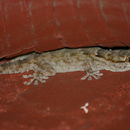en
names in breadcrumbs


A nocturnal species, more so than T. m.fascicularis. It tends to be more crepuscular during cooler times of the year. Insectivorous, and capable of taking fairly large prey, including other lizards. Loveridge (1947) reported it feeding on Ptyodactylus sp. in captivity. This might explain the scarce instances of coexistence between lizards of the genus Ptyodactylus and T. a. annularis in the wild. It is largely a sit-and-wait feeder, but will regularly actively forage. A very aggressive species with strong territorial inclinations. Males are particularly intolerant of conspecific intruders and will drive them off fiercely.
Least Concern
A robustly built lizard, which reaches large size, up to 140 mm SVL. Back and dorsal surface of tail covered with regular bands of low and smooth tubercles. Tubercles without clear rosettes of medium-sized scales. Tubercles are separated laterally from each other by 6-7 small scales. There is an average of 27 lamellae under the fifth toe. Temporal region covered with large tubercles widely separated by small scales. Postmentals smaller than the gulars. Rostral enters nostril. General color of dorsum ranges between dark brown-gray to light sandy-gray. Back with 4-5 dark and light crossbars and there are usually 4 distinctive white spots with dark borders on the scapular region. Tail with light and dark bands. Venter off-white.
Male larger than female, with broader head. General color of dorsum varies according to the dominant color of the habitat and environmental factors, such as temperature. The scapular spots are usually not easily discernible on juvenile animals and become well developed in adults.
Common and widespread in the Nile Valley and southern part of the Delta. It is also found in the southern part of Eastern Desert and scattered localities in the Western Desert.
Found mostly in the Sahelian and subtropical zones of Africa north of the tropical rain forest belt, from southern Morocco, Mauritania, and Senegal in the west to Egypt, Sudan, and Somalia in the east. The furthest north it reaches is along the Nile Valley in Egypt.
A mainly rupicolous species. Found in a variety of rocky habitats including cliffs, boulders, buildings, and ruins. Seldom found on trees. One animal was found by the author under the bark of an Acacia tree on the coastal plain east of Gebel Elba in April 1997. In the Nile Valley and Western Desert oases it is found mainly in or near human habitation. In the northern part of the Western Desert it has been found on isolated clusters of petrified trees, in otherwise open flat desert. In the Eastern Desert it inhabits wadis, especially near wells. Often seen on or near the ground at night in close proximity to favorable rocky microhabitats.
Subject to intensive collection by pet traders for the export market. Tens of thousands are exported every year from Egypt.
Tarentola annularis, also known as the white-spotted wall gecko or ringed wall gecko, is a species of gecko. It is native to northern Africa.[2]
Tarentola annularis, also known as the white-spotted wall gecko or ringed wall gecko, is a species of gecko. It is native to northern Africa.